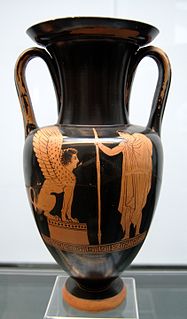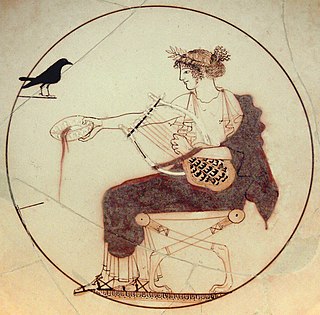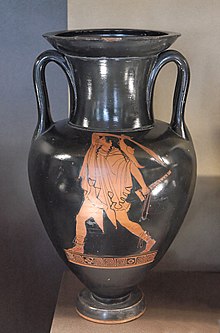
Ancient Greek pottery, due to its relative durability, comprises a large part of the archaeological record of ancient Greece, and since there is so much of it, it has exerted a disproportionately large influence on our understanding of Greek society. The shards of pots discarded or buried in the 1st millennium BC are still the best guide available to understand the customary life and mind of the ancient Greeks. There were several vessels produced locally for everyday and kitchen use, yet finer pottery from regions such as Attica was imported by other civilizations throughout the Mediterranean, such as the Etruscans in Italy. There were a multitude of specific regional varieties, such as the South Italian ancient Greek pottery.

Black-figure pottery painting, also known as the black-figure style or black-figure ceramic, is one of the styles of painting on antique Greek vases. It was especially common between the 7th and 5th centuries BC, although there are specimens dating as late as the 2nd century BC. Stylistically it can be distinguished from the preceding orientalizing period and the subsequent red-figure pottery style.

Exekias was an ancient Greek vase painter and potter who was active in Athens between roughly 545 BC and 530 BC. Exekias worked mainly in the black-figure technique, which involved the painting of scenes using a clay slip that fired to black, with details created through incision. Exekias is regarded by art historians as an artistic visionary whose masterful use of incision and psychologically sensitive compositions mark him as one of the greatest of all Attic vase painters. The Andokides painter and the Lysippides Painter are thought to have been students of Exekias.

Red-figure vase painting is one of the most important styles of figural Greek vase painting.

Euphronios was an ancient Greek vase painter and potter, active in Athens in the late 6th and early 5th centuries BC. As part of the so-called "Pioneer Group,", Euphronios was one of the most important artists of the red-figure technique. His works place him at the transition from Late Archaic to Early Classical art, and he is one of the first known artists in history to have signed his work.

The Achilles Painter was a vase-painter active ca. 470–425 BC. His name vase is an amphora, Vatican 16571, in the Vatican museums depicting Achilles and dated 450–445 BC. An armed and armored Achilles gazes pensively to the right with one hand on his hip. The other hand holds a spear. On the opposite surface a woman performs libation.

Nikosthenes was a potter of Greek black- and red-figure pottery in the time window 550–510 BC. He signed as the potter on over 120 black-figure vases, but only nine red-figure. Most of his vases were painted by someone else, called Painter N. Beazley considers the painting "slovenly and dissolute;" that is, not of high quality. In addition, he is thought to have worked with the painters Anakles, Oltos, Lydos and Epiktetos. Six's technique is believed to have been invented in Nikosthenes' workshop, possibly by Nikosthenes himself, around 530 BC. He is considered transitional between black-figure and red-figure pottery.

Lydos was an Attic vase painter in the black-figure style. Active between about 560 and 540 BC, he was the main representative of the '’’Lydos Group’’’. His signature, ό Λυδός, ho Lydos ", inscribed on two vases, is informative regarding the cultural background of the artist. Either he immigrated to Athens from the Lydian empire of King Kroisos, or he was born in Athens as the son of Lydian parents. In any case, he learned his trade in Athens.

White-ground technique is a style of white ancient Greek pottery and the painting in which figures appear on a white background. It developed in the region of Attica, dated to about 500 BC. It was especially associated with vases made for ritual and funerary use, if only because the painted surface was more fragile than in the other main techniques of black-figure and red-figure vase painting. Nevertheless, a wide range of subjects are depicted.
Geometric art is a phase of Greek art, characterized largely by geometric motifs in vase painting, that flourished towards the end of the Greek Dark Ages, c. 900–700 BC. Its center was in Athens, and from there the style spread among the trading cities of the Aegean. The Greek Dark Ages lasted from c. 1100 to 750 BC and include two periods, the Protogeometric period and the Geometric period, in reference to the characteristic pottery style. The vases had various uses or purposes within Greek society, including, but not limited to, funerary vases and symposium vases.

The Brygos Painter was an ancient Greek Attic red-figure vase painter of the Late Archaic period. Together with Onesimos, Douris and Makron, he is among the most important cup painters of his time. He was active in the first third of the 5th century BCE, especially in the 480s and 470s BCE. He was a prolific artist to whom over two hundred vases have been attributed, but he is perhaps best known for the Brygos Cup, a red-figure kylix in the Louvre which depicts the "iliupersis" or sack of Troy.

The Amasis Painter was an ancient Greek vase painter who worked in the black-figure technique. He owes his name to the signature of the potter Amasis, who signed twelve works painted by the same hand. At the time of the exhibition, "The Amasis Painter and His World" (1985), 132 vases had been attributed to this artist.

Hermonax was a Greek vase painter working in the red-figure style. He painted between c. 470 and 440 BC in Athens. Ten vases signed with the phrase "Hermonax has painted it" survive, mainly stamnoi and lekythoi. He is generally a painter of large pots, though some cups survive.

The Pan Painter was an ancient Greek vase-painter of the Attic red-figure style, probably active c. 480 to 450 BC. John Beazley attributed over 150 vases to his hand in 1912:
Cunning composition; rapid motion; quick deft draughtsmanship; strong and peculiar stylisation; a deliberate archaism, retaining old forms, but refining, refreshing, and galvanizing them; nothing noble or majestic, but grace, humour, vivacity, originality, and dramatic force: these are the qualities which mark the Boston krater, and which characterize the anonymous artist who, for the sake of convenience, may be called the 'master of the Boston Pan-vase', or, more briefly, 'the Pan-master'.

The Oreithyia Painter was an ancient Greek red-figure vase painter who flourished from 470–460 BCE. He is one of the many painters of the red-figure Classical Period, but his work is not considered the finest or well-known. This is partly because he began painting during the transition from red-figure to black-figure pottery.
The Tithonos Painter is the conventional name given to an Attic Greek red-figure vase-painter whose actual name never appeared on his works, which have been recognized in the 20th century when John Beazley identified his Late Archaic characteristic house style. Pots with decoration attributed to the Tithonos Painter are all Nolan amphorae and lekythoi. He has been characterized as "a competent but unoriginal craftsman", working under the influence of the Berlin Painter.

Amasis was an ancient Attic potter, active in Athens between 560/550 and 530/520 BC. Amasis’s pottery workshop also employed a well-known painter, who is conventionally named the Amasis Painter after the potter, and generally considered one of the best Archaic vase painters. His works are mostly black-figure, but some red-figure vase paintings by him do occur. He and Exekias produced the first major painted amphorae with a narrative image on front and back, respectively. Famous works:

Etruscan vase painting was produced from the 7th through the 4th centuries BC, and is a major element in Etruscan art. It was strongly influenced by Greek vase painting, and followed the main trends in style over the period. Besides being producers in their own right, the Etruscans were the main export market for Greek pottery outside Greece, and some Greek painters probably moved to Etruria, where richly decorated vases were a standard element of grave inventories.

The Judgement of Paris Amphora is an Attic black-figure amphora named for the scene depicted on it. It is held by the Musée des beaux-arts de Lyon with the inventory number E 581-c and is attributed to the London B76 Painter, who was active at Athens in the second quarter of the sixth century BC.

The Amphora of Hermonax in Würzburg is a neck amphora which was made by the early classical Attic vase painter Hermonax in the red figure style of Greek vase painting around 450 BC. The amphora was found in an Etruscan grave in Vulci. Originally kept in the Feoli collection, it now belongs to the antiquity collection of the Martin von Wagner Museum in Würzburg, where it is on display with a lid which probably does not belong to it.

















